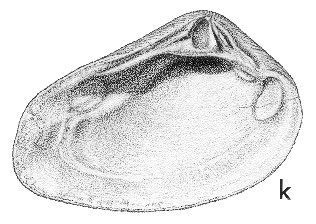
Revised descriptions of New Zealand Cenozoic Mollusca from Beu and Maxwell (1990)

 | Revised descriptions of New Zealand Cenozoic Mollusca from Beu and Maxwell (1990) | 
|
  (Pl. 18i): GS9520, J41/f8029, Awamoa Creek, Oamaru, Altonian (GNS) |
  (Pl. 18k): GS9520, J41/f8029, Awamoa Creek, Oamaru, Altonian (GNS) |
Beu & Maxwell (1990): Chapter 11; p. 186; pl. 18 i,k.
Synonymy: Crassatella trailli Hutton 1873b, p. 24; Crassatellites traili [sic]; Crassatellites obesus (A. Adams) (not of Adams)
Type species of Spissatella Finlay, 1926
Classification: Crassatellidae
Description: Size moderate for genus (length 40-50 mm), suboblong, moderately elongate (length: height 1.28-1.55) and inflated; posterior area well defined. Lunule strongly impressed in both valves; escutcheon much more prominent and more deeply impressed in right valve than in left. Commarginal sculpture of relatively prominent, low, narrow ridges on flanks (12-14 per cm at 1 cm from apex), much finer and more numerous on posterior area. Hinge very similar to that of S. subobesa (Pl. 11a).
Comparison: Specimens of Spissatella from Trig Z, Otiake (Waitakian) are similar to S. trailli in shape and size but are more finely sculptured, particularly on the umbones. Some individuals have commarginal ridges persisting throughout growth, but most have sculpture becoming obsolete or reduced to growth lines distally. They are inferred to be conspecific with an undescribed species in which commarginal sculpture is almost completely obsolete, common in Waitakian off-shore siltstone in the Hakataramea Valley and the upper Tengawai River. S. trailli differs from S. subobesa (Pl. 11a) in its less elongate shape and in having coarser commarginal sculpture. S. clifdenensis (Altonian, Clifden) is somewhat smaller than S. trailli (length about 40 mm), is less elongate (length: height 1.23-1.33), has a more sharply defined umbonal ridge, and has finer commarginal sculpture (17-20 ridges per cm at 1 cm from apex). The Altonian species "Spissatella" scopalveus (Target Gully Shellbed) differs from S. trailli in its more elongate shape (length: height 1.37-1.47), narrower posterior end and, most importantly, in its greater inflation and in having commarginal sculpture almost obsolete except on the umbones, and so is now referred to Eucrassatella.
Spissatella is well represented in shelf and upper slope assemblages from Kaiatan to Altonian, and less so from Clifdenian to Tongaporutuan. Some species, including S. subobesa and S. trailli, are among the most common molluscs in their respective faunules. The genus also occurs in Oligocene rocks in Victoria, Australia (S. maudensis (Pritchard, 1903), Janjukian; Darragh 1965, p. 110-111).
Spissatella is closely similar to Eucrassatella, but the species assigned to Spissatella are typically smaller and less strongly inflated than those of Eucrassatella, and have a less strongly convex ventral margin. Species of Spissatella also have commarginal sculpture persisting over most or all of the shell instead of being restricted to the umbonal region, and some more inflated species (e.g. S. scopalveus, Altonian, Target Gully, Oamaru) in which sculpture is obsolete on the adult are now referred to Eucrassatella. The two genera are very similar in hinge characters, although the right anterior cardinal tooth is typically better developed in Spissatella than in Eucrassatella.
Distribution: Otaian-Altonian; Mount Harris Formation, Awamoa Creek, Oamaru, Altonian (type) and other Altonian localities in Oamaru district; Mt Harris; Bluecliffs, Otaio River. Common to very common at most localities.
Cite this publication as: "A.G. Beu and J.I. Raine (2009). Revised
descriptions of New Zealand Cenozoic Mollusca from Beu and Maxwell (1990). GNS
Science miscellaneous series no. 27."
© GNS Science, 2009
ISBN
978-0-478-19705-1
ISSN 1177-2441
(Included with a PDF facsimile file
copy of New Zealand Geological Survey Paleontological Bulletin 58 in CD version
from: Publications Officer, GNS Science, P.O. Box 30368 Lower Hutt, New
Zealand)